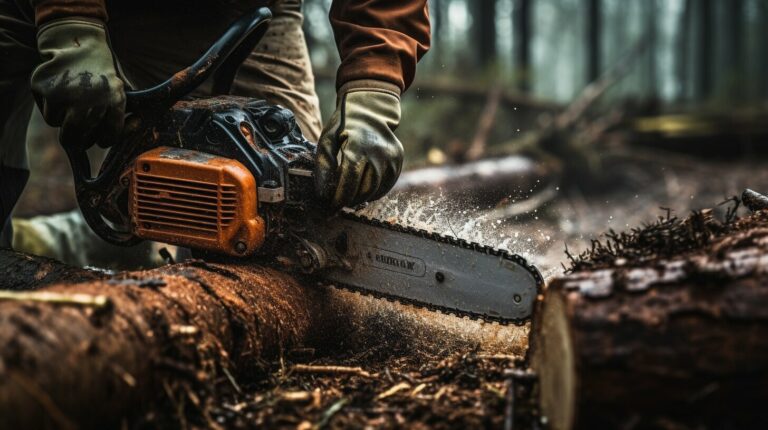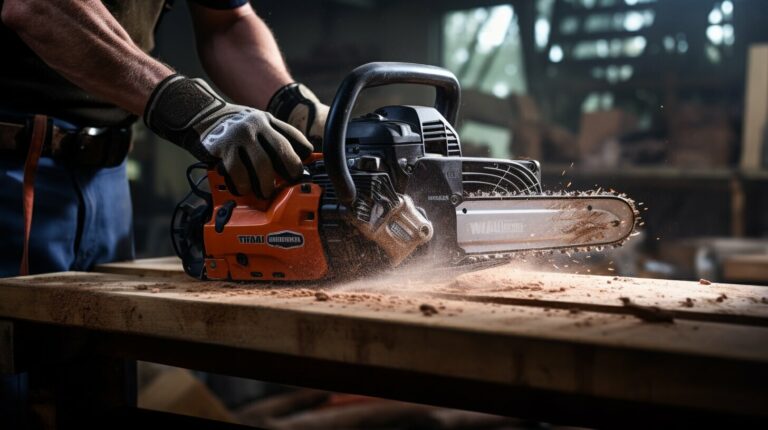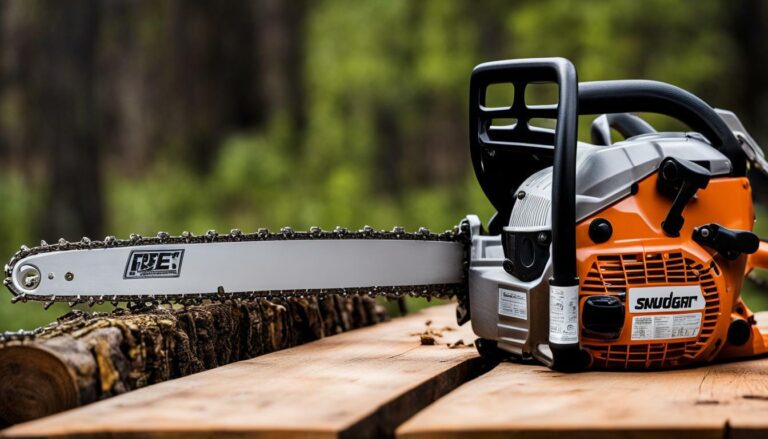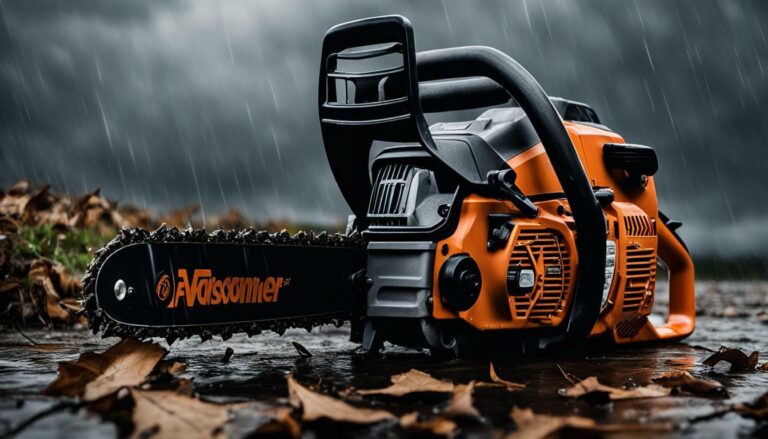Learn How to Put a Chain on a Chainsaw Easily & Safely
How to Put a Chain on a Chainsaw correctly is important for both safety and performance reasons. The direction of the chain is always clockwise when looking at it from the right side of the chainsaw. This ensures that the chain moves forward and away from you. All chainsaws follow this standard direction. Installing the chain incorrectly can lead to issues such as the chainsaw not cutting correctly, damage to the drive sprocket, increased risk of kickback, burning of the wood, and the chain coming off or getting ripped off.
How to Put a Chain on a Chainsaw correctly, follow these steps:
- Turn off the engine and disengage the chain brake.
- Loosen the chain tensioning screw.
- Finger-loosen the nuts on the clutch cover.
- Remove the chain and bar.
- Check the compatibility of the new chain with the bar and saw.
- Put the chain onto the bar in the correct direction, with the cutters pointing toward the bar’s tip.
- Attach the bar back to the saw.
- Place the chain around the sprocket, ensuring the drive links are seated correctly.
- Tighten the cover.
- Adjust the chain tensioner to set the correct tension.
- Check the chain for free movement.
When putting on a chainsaw chain, taking safety precautions is essential. Wear protective clothing and always hold the chainsaw firmly with both hands. Avoid kickback incidents by not touching the upper tip of the saw to any object, not pinching the chain, and checking the area for obstacles before cutting. Additionally, proper maintenance and adherence to safety precautions should always be followed when using a chainsaw.
Key Takeaways:
- Putting a chain on a chainsaw correctly is crucial for safety and performance.
- The chain should always be installed clockwise when viewed from the right side of the chainsaw.
- Incorrect chain installation can lead to various issues, including improper cutting and damage to the drive sprocket.
- Follow the step-by-step guide to correctly put on a chainsaw chain, ensuring compatibility and adjusting the tension.
- Always prioritize safety by wearing protective clothing, holding the chainsaw firmly, and avoiding kickback incidents.
How to Install a Chain On A Chainsaw

Putting a chain on a chainsaw may seem simple, but it is crucial to do it correctly to ensure safety and performance. Incorrectly installing the chain can lead to many problems, including the chainsaw not cutting correctly, damage to the drive sprocket, and an increased risk of kickback. Additionally, if the chain is not installed correctly, it can result in the burning of the wood and the chain coming off or getting ripped off.
One of the most common signs that the chain is backward is when it fails to cut effectively. If you notice that the chain is not cutting or if you experience excessive vibration while using the chainsaw, there is a possibility that the chain has been installed incorrectly. Other signs to look out for include the chain coming off the bar, strange noises from the drive sprocket, and the smell of smoke or burning. These issues can affect the chainsaw’s performance and pose risks to the user and those in the vicinity.
To ensure correct chain installation, follow these steps: turn off the engine and make sure the chain brake is not engaged. Loosen the chain tensioning screw and finger-loosen the nuts on the clutch cover. Remove the chain and bar, and check the compatibility of the new chain with the bar and saw. Ensure the cutters point toward the bar’s tip when putting the chain on. Reattach the bar to the saw, place the chain around the chain sprocket, and make sure the drive links are seated correctly. Finally, tighten the cover, adjust the chain tensioner to the appropriate tension, and check that the chain moves freely.
While installing a chainsaw chain correctly is essential, it is also crucial to prioritize safety. Always wear protective clothing and hold the chainsaw firmly with both hands. Avoid kickback incidents by not touching the upper tip of the saw to any object and by avoiding pinching the chain. Before cutting, check the area for any obstacles that could pose a hazard. Remember, proper maintenance and adherence to safety precautions are crucial for a chainsaw’s safe and efficient use.
| Common Signs of Incorrect Chain Installation: |
|---|
| – Chain not cutting effectively |
| – Excessive vibration |
| – Chain coming off the bar |
| – Strange noises from the drive sprocket |
| – Smoke or burning smell |
Steps for Properly How to Put a Chain on a Chainsaw
When putting on a chainsaw chain, there are several important steps to ensure safety and optimal performance. Here is a step-by-step guide:
- Start by turning off the engine and ensuring the chain brake is disengaged. This will prevent any accidental start-up or movement of the chain.
- Next, loosen the chain tensioning screw to relieve tension on the old chain. Then, use your fingers to loosen the nuts on the clutch cover.
- Remove the old chain and bar from the chainsaw. Take this opportunity to inspect the bar for any signs of wear or damage.
- Before putting on the new chain, check its compatibility with the bar and the chainsaw. Ensure that the chain length and pitch match the specifications for your particular chainsaw model.
- Now, place the new chain onto the bar in the correct direction. The cutters should be pointing toward the tip of the bar. Double-check that the chain is properly aligned.
- Attach the bar back to the chainsaw, ensuring the chain tensioning screw is properly positioned in the bar hole. Finger-tighten the nuts on the clutch cover.
- Next, place the chain around the sprocket, ensuring the drive links are seated correctly. Make sure the chain is properly seated on the bar as well.
- Tighten the cover by using a wrench or tool provided with the chainsaw. Be careful not to overtighten the nuts.
- Adjust the chain tensioner to set the correct tension. A properly tensioned chain should be snug against the bottom of the bar but still able to move freely.
- Finally, check the chain to ensure it moves freely without obstructions or tight spots. Adjust the tension further if needed.
These steps will help you correctly put on a chainsaw chain, ensuring safety and optimal performance. Always remember to wear protective clothing, hold the chainsaw firmly with both hands and follow other necessary safety precautions to minimize the risk of accidents.
| Step | Description |
|---|---|
| 1 | Turn off the engine and disengage the chain brake. |
| 2 | Loosen the chain tensioning screw and finger-loosen the nuts on the clutch cover. |
| 3 | Remove the old chain and bar from the chainsaw. |
| 4 | Check the compatibility of the new chain with the bar and chainsaw. |
| 5 | Put the new chain on the bar in the correct direction, with the cutters pointing toward the tip of the bar. |
| 6 | Attach the bar back to the chainsaw and finger-tighten the nuts on the clutch cover. |
| 7 | Place the chain around the chain sprocket, ensuring proper seating of the drive links. |
| 8 | Tighten the cover securely, but not overtighten the nuts. |
| 9 | Adjust the chain tensioner to set the correct tension. |
| 10 | Check the chain for free movement without any obstructions. |
Safety Precautions When Putting on a Chainsaw Chain
When it comes to putting on a chainsaw chain, safety should always be the top priority. To ensure a safe and successful chain installation, it is important to take the following precautions:
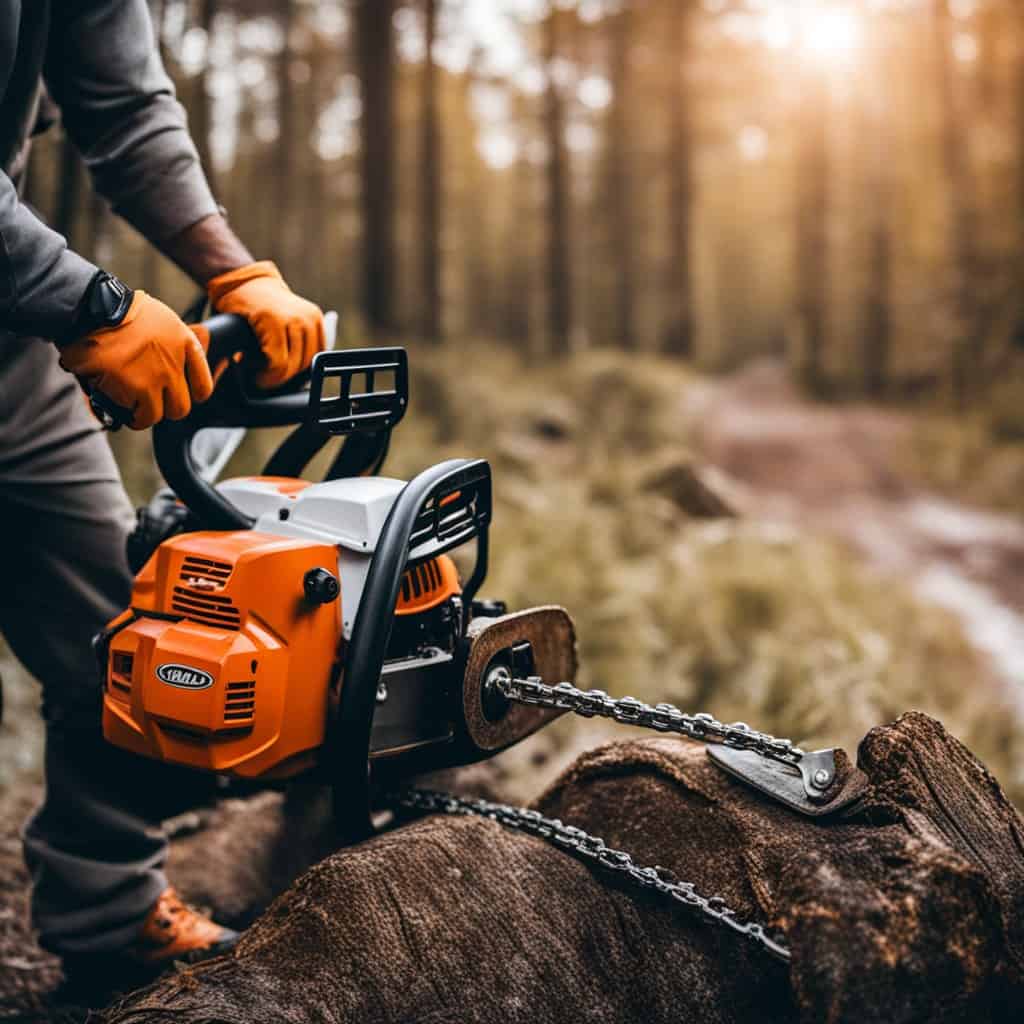
- Wear protective clothing: Before you begin, make sure you are dressed appropriately. Wear safety glasses, hearing protection, gloves, and sturdy footwear to protect yourself from potential hazards.
- Hold the chainsaw firmly: When handling the chainsaw, always grip it with both hands for maximum control. This will help you maintain a steady grip and reduce the risk of accidents.
- Avoid kickback: Kickback is a common cause of chainsaw accidents and can occur when the upper tip of the saw comes into contact with an object. To prevent kickback, never touch the upper tip of the saw to any object while operating the chainsaw.
- Do not pinch the chain: When installing the chain, be careful not to pinch your fingers or any other part of your body between the chain and the bar. Keep your hands clear of the chain and ensure it is properly seated in the bar’s groove.
- Check the area for obstacles: Before you start cutting, carefully inspect the area to ensure no obstacles could interfere with your work. Remove any debris, branches, or other objects that may pose a risk.
Note:
Following these safety precautions will help minimize the risk of accidents and ensure a safe and successful chain installation. Always prioritize safety when working with chainsaws to protect yourself and those around you.
Maintenance and Safety Precautions for Chainsaw Use
Proper maintenance and adherence to safety precautions are essential when using a chainsaw. By following these guidelines, you can ensure a safe and efficient operation, prolong the lifespan of your chainsaw, and prevent accidents or injuries.
Proper Maintenance
To keep your chainsaw in optimal condition, regular maintenance is key. Here are a few maintenance tasks to prioritize:
- Clean and lubricate – Remove debris, sawdust, and dirt from the chainsaw after each use. Clean the chain bar groove and sprocket, and lubricate them with a high-quality chainsaw oil to prevent rust and ensure smooth operation.
- Sharpen the chain – A dull chain can lead to inefficient cutting and increased strain on the chainsaw’s engine. Use a chainsaw file or a sharpening tool to maintain a sharp cutting edge on the chain.
- Tension the chain – Regularly check and adjust the chain tension according to the manufacturer’s instructions. A loose chain can come off during operation, while an overly tight chain can damage the bar and sprocket.
Safety Precautions
When operating a chainsaw, it is crucial to prioritize safety. Here are some essential safety precautions to keep in mind:
- Wear protective clothing – Always wear safety gear, including a helmet, ear protection, gloves, safety glasses, and sturdy boots. Additionally, consider using chainsaw chaps to protect your legs.
- Hold the chainsaw firmly – Grip the chainsaw with both hands, ensuring a firm and secure hold. Maintain a balanced stance while operating the chainsaw with your feet shoulder-width apart.
- Avoid kickback – Kickback occurs when the chain’s tip comes into contact with an object, causing a sudden upward and backward motion. To avoid kickback, do not touch the upper tip of the saw to any object, and hold the chainsaw at the proper angle.
- Check the area – Before cutting, survey the area for any obstacles, such as nails, wires, or branches, that may interfere with the cutting process. Clear the workspace to prevent accidents.
By following proper maintenance routines and safety precautions, you can ensure the longevity of your chainsaw and protect yourself from potential hazards. Always consult the manufacturer’s manual for specific instructions on maintenance and safety procedures.
| Maintenance Tasks | Safety Precautions |
|---|---|
| Clean and lubricate the chainsaw after each use. | Wear protective clothing, including a helmet, gloves, and safety glasses. |
| Sharpen the chain regularly to maintain cutting efficiency. | Hold the chainsaw with both hands and avoid kickback incidents. |
| Check and adjust the chain tension according to the manufacturer’s instructions. | Survey the cutting area for obstacles before starting. |
Conclusion
How to Put a Chain on a Chainsaw might seem simple, but it is crucial to do it correctly to ensure your safety and the saw’s performance. When installing the chain, always remember that the direction should be clockwise when viewed from the right side of the chainsaw. This ensures the chain moves forward and away from you, reducing the risk of accidents.
Incorrect installation can lead to various issues, including improper cutting, damage to the drive sprocket, increased risk of kickback, burning of the wood, and the chain coming off or getting ripped off. Suppose you notice signs that the chain is on backward, such as the chain not cutting, excessive vibration, or strange noises from the drive sprocket. In that case, it is important to correct the installation immediately.
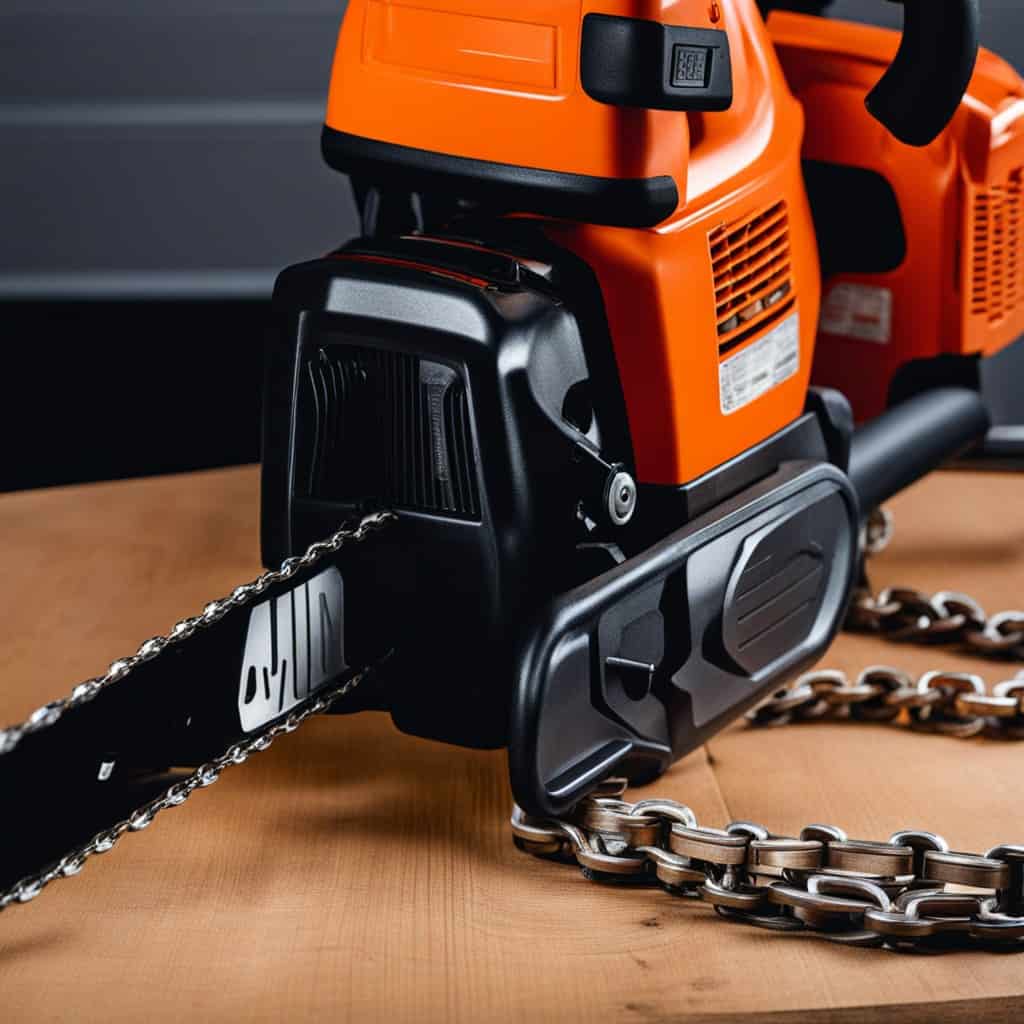
To put on a chainsaw chain correctly, turn off the engine and disengage the brake. Loosen the chain tensioning screw and finger-loosen the nuts on the clutch cover. Remove the old chain and bar, and check the compatibility of the new chain with the bar and saw. Place the chain onto the bar in the correct direction, with the cutters pointing toward the bar’s tip. Reattach the bar to the saw and place the chain around the sprocket, ensuring the drive links are seated correctly. Tighten the cover and adjust the chain tensioner to set the correct tension. Finally, check that the chain moves freely before using the saw.
When putting on a chainsaw chain, it is essential to prioritize safety. Always wear protective clothing and hold the chainsaw firmly with both hands. Avoid kickback incidents by not touching the upper tip of the saw to any object and not pinching the chain. Before cutting, thoroughly check the surrounding area for any obstacles that could interfere with your work. Remember that proper maintenance and adherence to safety precautions are crucial for a chainsaw’s safe and efficient use.
FAQ
Why is it important to put a chainsaw chain on correctly?
Putting a chainsaw chain on correctly is important for safety and performance reasons. Incorrect installation can lead to issues such as the chainsaw not cutting properly, damage to the drive sprocket, increased risk of kickback, burning of the wood, and the chain coming off or getting ripped off.
How can I tell if the chainsaw chain is on backward?
Signs that the chain is on backward include the chain not cutting, excessive vibration, the chain coming off the bar, strange noises from the drive sprocket, and smoke or burning smell.
What safety precautions should I take when putting on a chainsaw chain?
When putting on a chainsaw chain, wearing protective clothing and holding the chainsaw firmly with both hands is important. To avoid kickback, do not touch the upper tip of the saw to any object, avoid pinching the chain, and always check the area for obstacles before cutting.
What maintenance and safety precautions are important for using a chainsaw?
Proper maintenance and safety precautions should be followed when using a chainsaw. This includes regular maintenance tasks to keep the chainsaw in good working condition and following all safety guidelines for safe operation.

